| Lista Light |  |
Tonga to Fiji
En route to our overnight stop to the west of the Vavau group, we first stopped off at the famous Mariner's cave - a cave entered by swimming down a few meters and along five meters into a rock face. The phenomenon created by the variations of pressure when waves hit the rocks is that a mist forms around you…
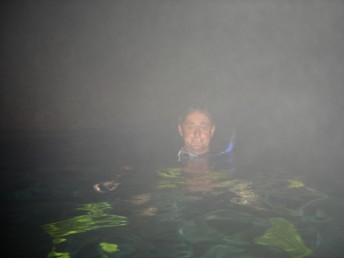
... then completely vanishes as the pressure changes - all very strange !
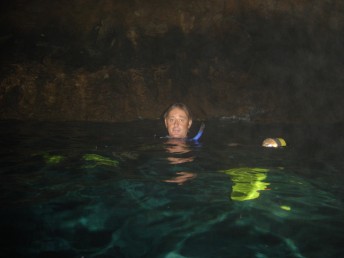
The blue light coming into the cave through the underwater passage was impressive, from both on top of the water and underneath.
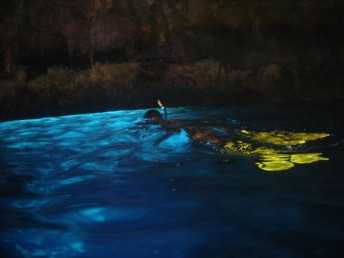
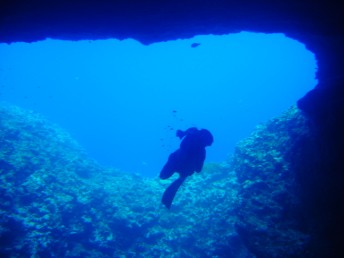
After our small caving trip, we carried on to the island of Hunga, where we went through a small pass into the lagoon there - unfortunately the remainder of the afternoon and the next morning were overcast and rainy, but we went for an enjoyable snorkel in the lagoon pass the next morning, still hunting for the elusive whale experience!
By 3pm the tide was high enough to attempt leaving the lagoon, and we set off towards Fiji with a light following wind which was just enough to carry us along at a fair speed for an hour or two after we had left the wind shadow of the island.
We had got a weather forecast from a friend, and we were expecting SE wind, F5 to arrive, followed by less wind for a day, then NE F6 following a day or so later - the perfect amount of wind to get us sailing along nicely. However, just after midnight the wind swung around a few times, then suddenly got up, and carried on getting up, until we were bowling along with F8 winds, gusting up to 40 knots, with enormous waves and spray everywhere. We had a reef in the main already, but we didn't have time to take any more, since we were trying to gybe as the wind got up and having problems with a caught running backstay - so we had to run under only one reef in the main, which was a lot more canvas than we needed, and a lot to attempt to pull down. A few tired looking birds had landed on deck a little earlier, which is not a common occurrence - we should have taken the hint that there was some bad weather coming ! By 3am, the wind had abated slightly, to F7, but we were left with a big sea and lots of rain, and we were still doing 7 knots with reefed mainsail only.
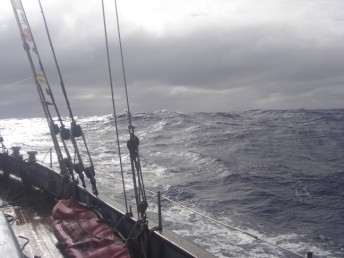
The high winds, at least F5, stayed with us all day, together with lots of rain and cloud - we all got thoroughly wet and cold !
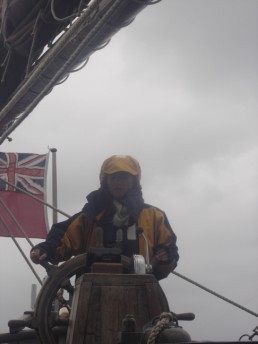
The next evening we had more strong winds, up to F7 this time, and zoomed along over big waves again - this time we were more prepared for it and took three reefs in the main before things got too bad. By the next morning, things were looking better and by lunchtime we were going along nicely, with manageable wind and clear, sunny skies. That afternoon we passed through a passage in the reef between Tonga and Fiji, and were helped along by up to two knots of current. The sea had calmed down enough for the fish to see our lures, and we caught a large Mahi-Mahi which was delicious eating for several days.
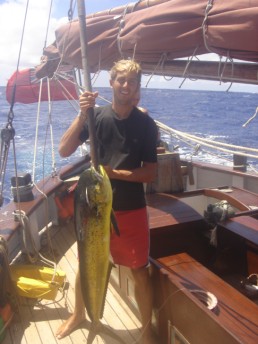
By midnight the wind had died enough to require engine, and the next day was hot and sunny, with very little wind - it was so hot the boys had to jump into the sea and act as shark-bait on a rope.
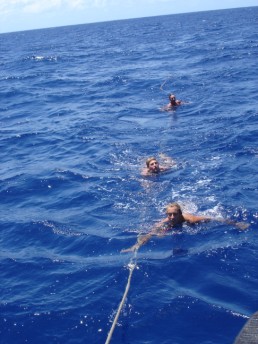
The other entertainment of the day was passing the international date line (or where it should be anyway - 180 degrees West/East). This meant that we had travelled exactly half-way around the world since leaving England, taking 15 months and travelling somewhere in the region of 15,000 miles at an average of 5-6 mph! Although we felt Neptune didn’t deserve much in the way of offerings after the weather we'd had a few days before, we gave him a can of beer over the side to show willing, and then carried on with the arduous tasks of the day.
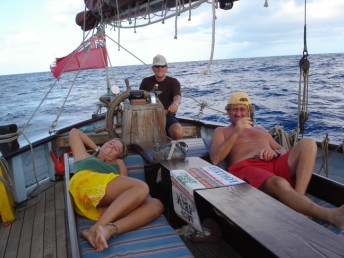
The last night of the passage was fairly dull and windless, with the odd squall and torrential rain to keep us on our toes. The GPS, which is mounted outside near the wheel so that we can use it to aid steering, finally gave in to the heavy rain and got waterlogged, which spelt the end for the display screen, although it can still get a position and we can read it out from the repeater below.
We arrived outside Suva harbour just as dawn broke, and came in to anchor near the Yacht Club by 7:30am.
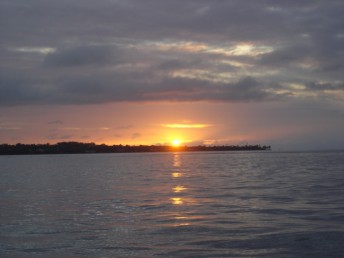
Suva, the busiest Pacific port so far encountered, hardly boasted clear water for swimming, and was jammed full of fishing and cargo ships - the only consolation was that the murky water completely killed all the travelling weed that had grown on the side of the boat!
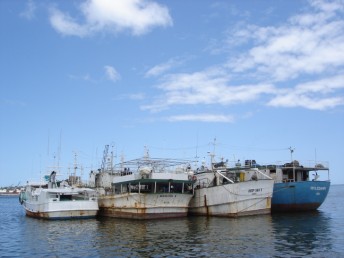
Rob embarked on the usual entertainment of checking into the country, this time assisted by Cees, and was particularly pleased to award Fiji first place for paperwork required, overtaking Panama as the previous winner. There was Customs to see, requiring five forms to be filled in (all in triplicate with carbon paper of course), requiring full details of crew and the boat, often with the same details required on different forms. Quarantine then arrived, requiring another form and $30, followed by Health and their form; the quirk being that in order to pay for the 'health inspection' a taxi ride was required to a building out of town which was two minutes walk from the address given to us so that a receipt could be obtained, the number from this receipt was then required in a different office on the other side of town. Immigration was then visited, in an unmarked portacabin inside a warehouse, requiring all crew details yet again, both on separate forms and a joint boat form. Then came the enjoyment of obtaining a cruising permit, and a taxi ride to another suburb of Suva, where an unlabelled No.17 Richards road was eventually found after asking two people and two trips up and down the road, the difficulty being that the numbers jumped around with gaps of thirty or more between neighbouring houses. Having finally found the correct place, we were told that the office of Fijian Affairs had moved to a new office building three weeks previously, so back to town to finally get the cruising permit, and another form to be filled in. For good measure, on the way back through the Yacht club, we had another form to fill in to register, and all this only took 5 hours from 9am until 2pm. The various officials were left with a large pile of paper, and we retained just 9 items for our file!
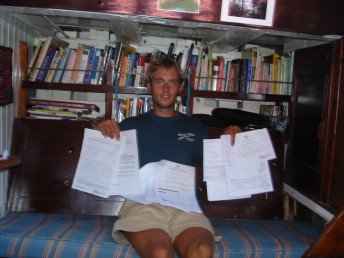
Foreseeing the usual complications of five people wanting to go ashore at different times and only one dingy to do it in, we decided it would be easier to tie up on the outside of the marina so we could come and go as we pleased; later on in the afternoon, when the tide was high enough to get in, we brought the boat in, just in time to go for a sundowner at the yacht club.
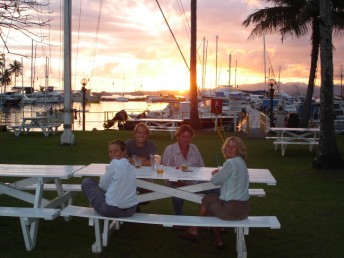
The famous fish and chips had run out, so we headed into town for an amazingly cheap curry, canteen style. Fiji has a big Indian contingent, about half of the population, which means good cheap curry, although Merryn was disappointed by the amount of cockroaches scurrying around near the kitchen!
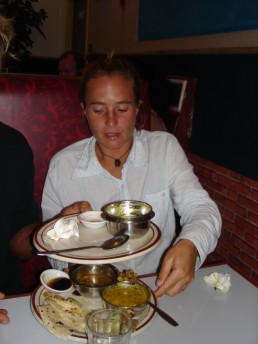
The next morning, after a quick haircut, it was time to explore the town,
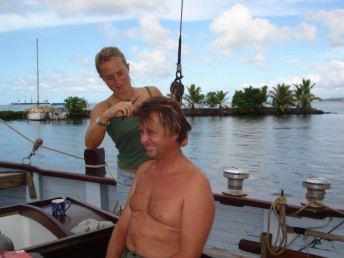
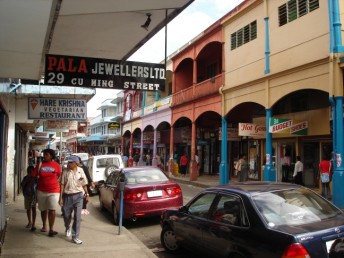
the market,
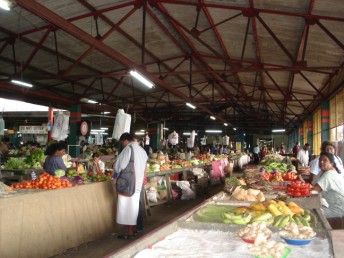
and the museum, with their displays of traditional Fijian cannibals' human flesh forks!
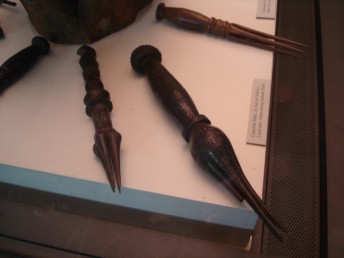
The next morning Rob and Merryn hired a car (complete with flat tyre and complimentary cockroaches) to drive down the coast for a night away, but first we all piled in to visit the rainforest just outside Suva for the morning. After some discussion of the best route,
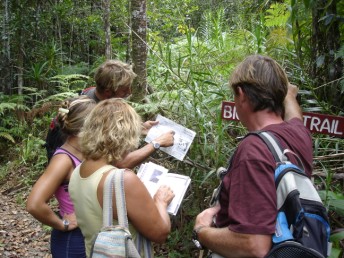
we walked through the forest paths, finding waterfalls, pools, a rope swing and picnic tables as we went.
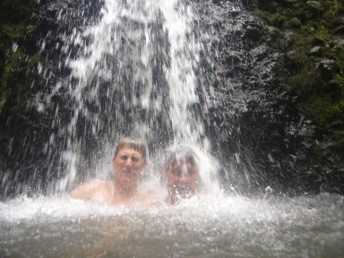
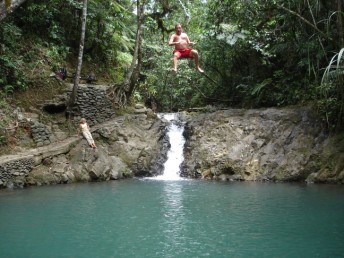
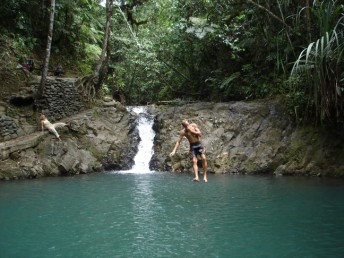
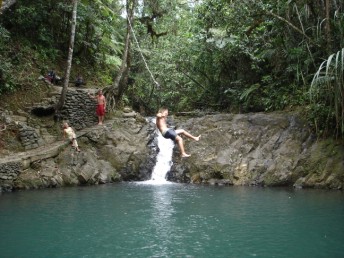
By the time we got out of the forest, the packed lunch had long been devoured and appetites had been enhanced by all the activities, so Jay, Jack and Cees went off to a nearby lodge for a relaxed lunch and return to Suva by bus,
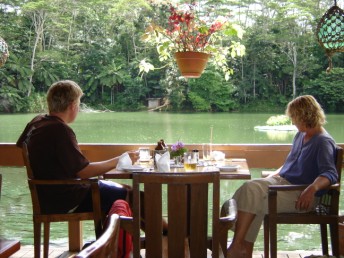
and Rob and Merryn carried on down the coast, eventually finding a secluded resort and their own small bure (Fijian style thatched dwelling) for the night.
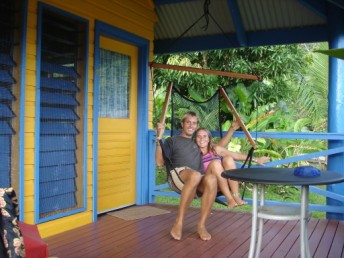
After a hurried drive back from the south coast the next morning, passing more roadside houses hidden in the lush Fijian vegetation growing on the wet East side of the island,
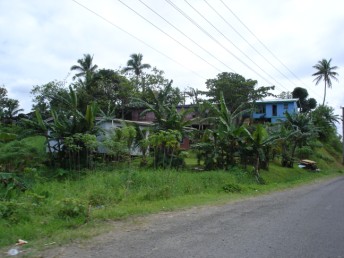
Rob and Merryn got back to the boat to find the tide falling faster than expected, and everyone else still out in town shopping, so took the boat back out to anchor in the bay before the depth wasn't enough to actually get out of the marina. There then followed another hour of paperwork to check out of Suva, one of the forms being exactly the same as the form required on the way in, then we were off again, headed to the Mamanuca islands off the south west corner of Viti Levu, via two overnight stops, one of which was a lovely sandy bay.
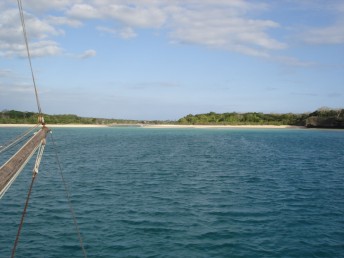
Arriving at the Mamanucca group of islands, and passing through Wilkes passage in the outlying reef, we headed straight for Musket Cove, a resort that welcomes yachties and where people gather before heading down to New Zealand or Australia.
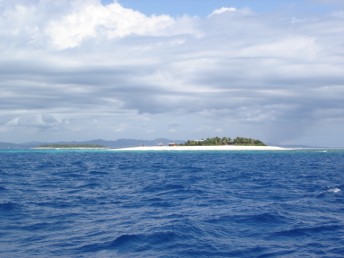
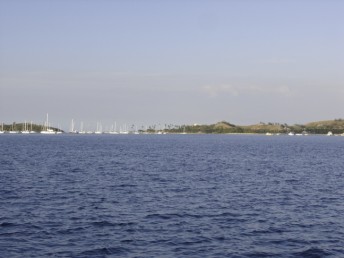
Anchored off the resort gave us plenty of opportunity to enjoy the bars and restaurant, and the snorkelling off a small sand cay just outside the anchorage. Merryn hunted out the lilo that Polly kindly left behind and did her own version of snorkelling, relaxed style.
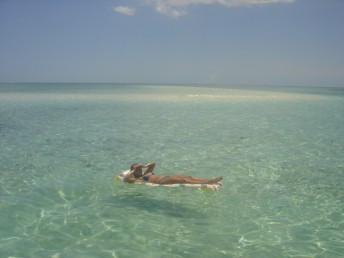
After a few days we went for a cruise to nearby Castaway Island, picking a path through the reefs and coral areas, with Jack and Cees posted at the bow checking we weren't about to plough into something.
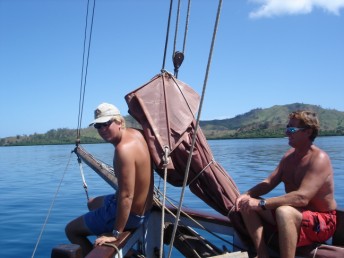
After a stop for lunch, a good snorkel and a walk on the shore at the behind Castaway Island …
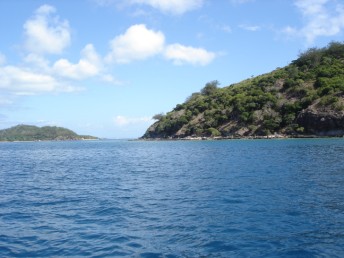
… we returned to Musket Cove, leaving again a few days later to go to a dive spot near Musket Cove in the morning, which was a couple of large pinnacles off the end of the reef, and loads of fish, including one very large fat puffer fish.
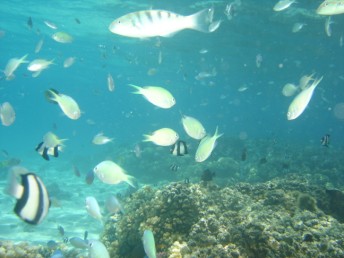
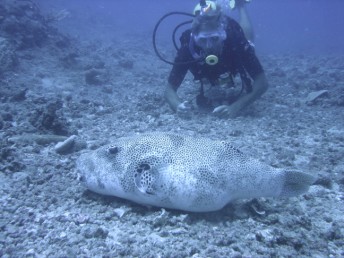
After motoring most of the day, in very light winds, we arrived at Bounty Island just as the light was starting to fade, and managed to catch a lovely big fish for supper just before we anchored - it was a 'narrow barred Spanish mackerel' and is one of the few fish with the four star rating in our fish book.
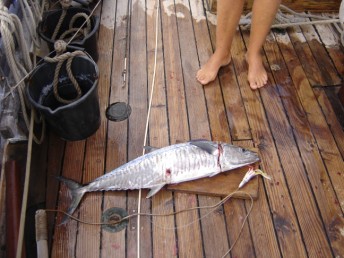
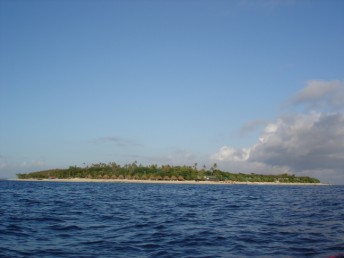
We felt it right that the fish needed a barbeque to do it justice, and during the lighting process Rob came up with the best tool so far for getting the blaze going - his diving flipper (try it!)
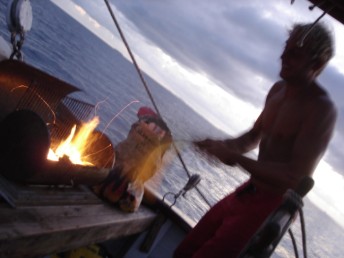
After an early night due to stuffing ourselves so full of delicious fish we couldn’t move, we all got in the water and snorkelled over the nearby reef, which had good coral pinnacles in the deep water near the boat. Merryn and Rob walked around the island in less than an hour - beach all the way!
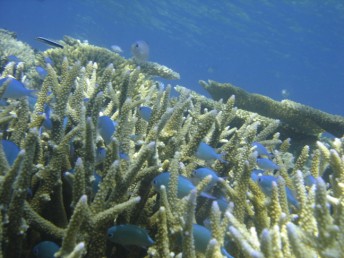
We then headed off to Vuda Point Marina after lunch, our land base for a few days whilst exploring the west coast, and fitted snugly into a gap between two other boats in the hurricane hole harbour.
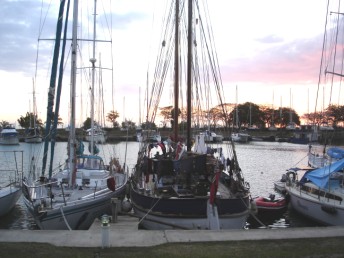
As patrons of the marina we found ourselves to be guests of the adjioining resort with use of their swimming pool, a bonus which competed against the heat, no wind, mosquitos all night and being unable to jump over the side into the sea to cool off!
First town to visit was Nadi (pronounced Nandi), a fairly touristy town with lots of clothing shops and a large temple at one end.
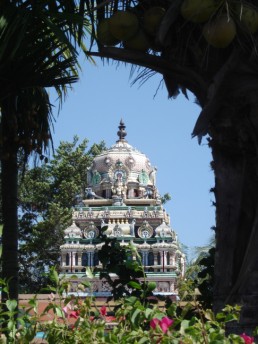
We had made our way through the supplies of beer and spirits from Rarotonga, so Merryn and Rob returned home from Nadi duty free shops with a few cases of beer, and Jack brought home a bottle of whisky; unfortunately the latter was emptied, very much to the detriment of all the next morning, especially Rob!
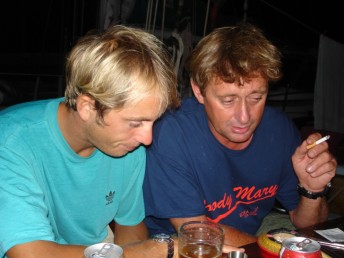
Lautoka the next day was a much more industrial town, with the smell and smoke of sugar cane factories filling the air, and lots of narrow guage railways with sugar cane trains and lorries piled high with sugar cane taking the crop to the factories.
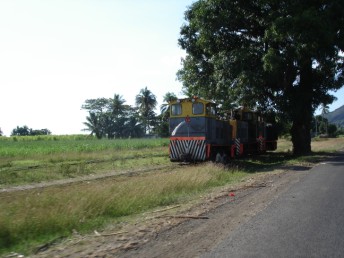
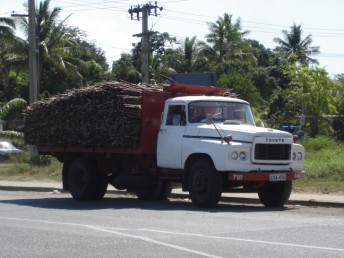
Rob had to go through the entire checking in and out procedure for immigration and customs again which is never a nice prospect with a hangover, while Jay and Jack went to the local market for provisions, and then went to the "Garden of the Sleeping Giant" with Cees on the way home, a mountain garden filled with orchids.
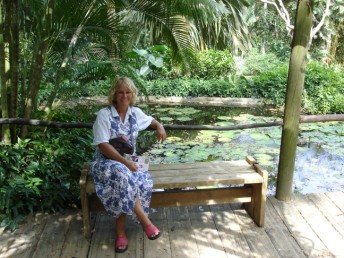
Meanwhile Merryn and Rob spent the rest of the day attempting to find an internet café that was good enough for the website update, and then went to the supermarket for a big shop of stores needed for the journey to New Zealand.
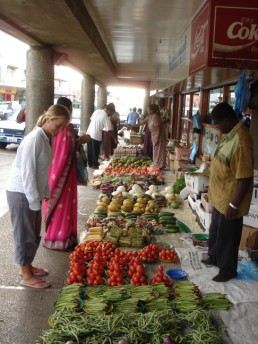
The next day, our last day on the mainland, Jay had arranged a pick-up truck to take us to see a village in the hills where we could see native Fijian life, and go for a hike in the hills.
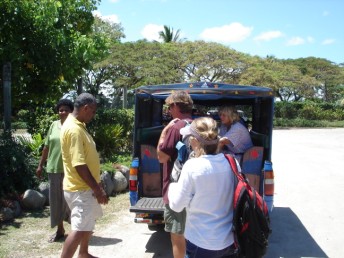
After an hour of bum-numbing transport over tracks in the hills we finally arrived at the village and went on a three hour hike over the hills, taking in the obligatory waterfall and good views all the way to the sea, followed by a cooling swim in the river.
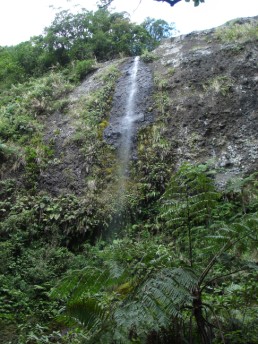
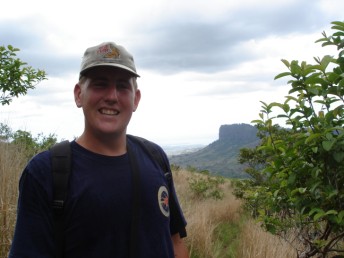
Back at the village we were going to say hello to the chief but unfortunately this was the wrong time so we couldn’t. Fijian culture has a lot of tradition about arriving at a village, where you mustn't enter until you are met, and then you take the chief a gift of Kava, the root of a pepper plant, which is ground and mixed into a mildly anasthetic drink and is drunk as part of a ceremony. Unfortunately the kava drink is muddy and vile tasting, and from the first time we tried it in Tonga were not too interested in drinking it again (except Jack, who had it several times in the interim and was nominated the kava expert).
Almost relieved to be saved from having to drink Kava when our lift arrived, we left the collection of huts with woven Pandanus sides and went back to the boat.
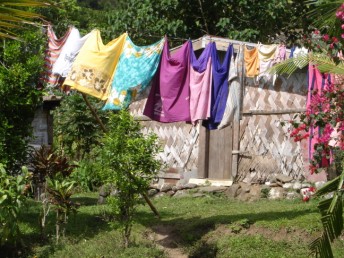
Burning out of the marina at full blast we headed towards Beachcomber island, apparently notorious for having an active nightlife, hoping to arrive and anchor before dark. Unfortunately the light faded quickly and after a close encounter with the reef surrounding the island we turned back to the previous island (Treasure Island) which had an easier approach and was more sheltered.
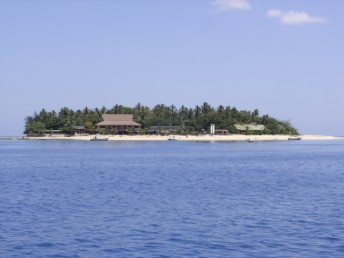
Despite the different venue we had a good time that evening at the resort bar on Treasure Island dancing to the band, and after a lunchtime stop for Rob and Cees to go diving looking for a wreck of a plane on the sea floor the next day (which they didn’t find) we returned once again to Musket Cove for our final night in Fiji.
We left early the next afternoon for Opua, New Zealand, a trip of about 1100 miles, and the final passage of the journey.
Back to previous section - Cook Islands to Tonga (via Niue)
Forward to next section - Fiji to New Zealand
This page hit Count : 208964
This is the Lista Light Website, for the travels of the sailing boat Lista Light
Click here for text-version of site